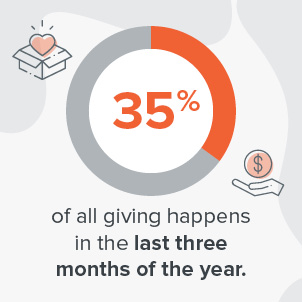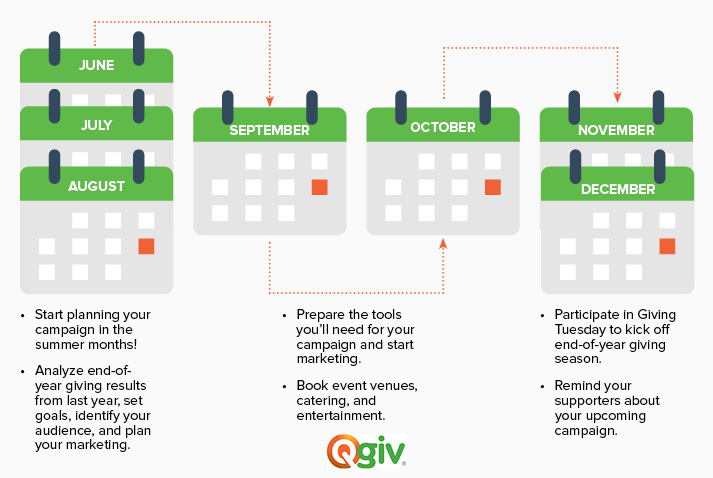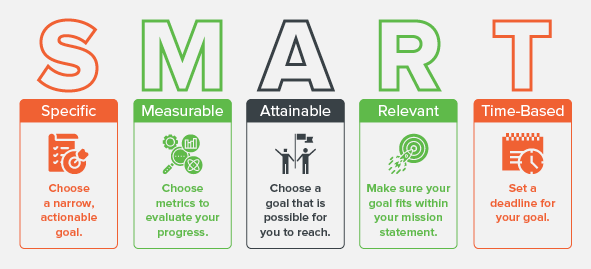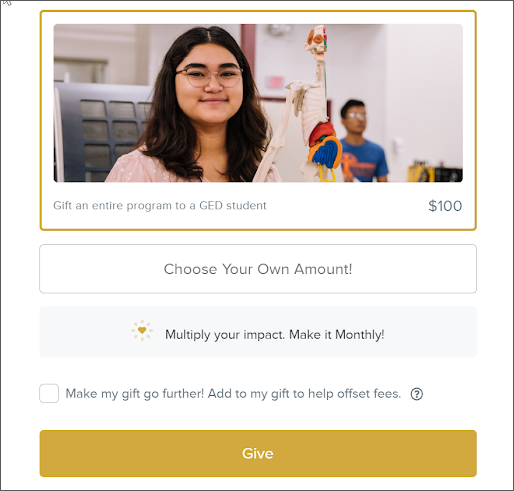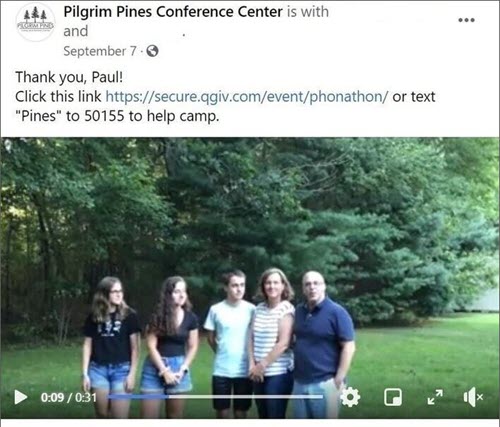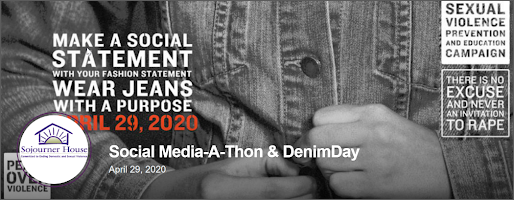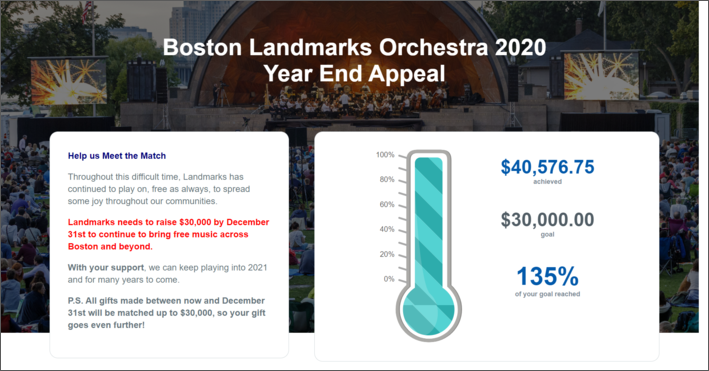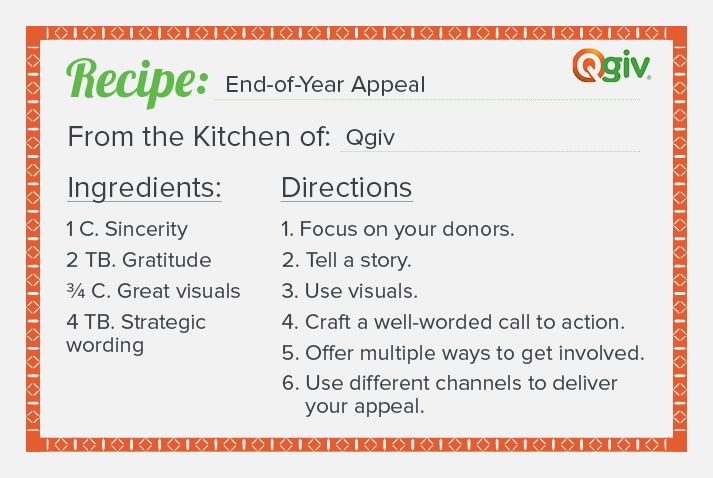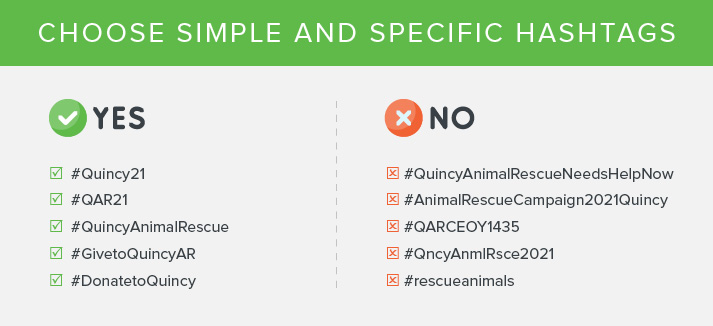The final months of the calendar year bring out the best in all of us. Holiday celebrations and time spent with family and friends help us reconnect to the things that matter most and prepare to start fresh for the new year ahead.
This is why so many people like to give to their favorite nonprofits during the end-of-year giving season. Generosity is running high and people are looking for ways to do some good in their communities.
However, end-of-year giving can sneak up on nonprofits that don’t have a plan. This is why it’s critical to start preparing early for a successful campaign.
Why is an end-of-year giving plan important for nonprofits?
End-of-year giving season spans from Thanksgiving and Giving Tuesday (the Tuesday after Thanksgiving) all the way through to New Year’s Day.
And the importance of this end-of-year giving season for nonprofits can’t be overstated. According to our research, 35% of all nonprofit giving happens in the last three months of the year. And, incredibly, 12% of all giving happens in the last three days of the year.
There are a number of reasons for this end-of-year surge in donations, including:
- Generosity stemming from the holiday season
- A desire to turn over a new leaf going into the new year
- The opportunity to take advantage of tax benefits for donating before the end of the year
No matter your donors’ reasons for giving, the stats above show that at the end of the year, they’re ready and willing to give. It’s your job to set up your end-of-year campaign so that you succeed in pulling in last-minute donations.
In this article, we’ll walk through 21 end-of-year giving best practices to help your nonprofit end the fundraising year with a bang:
- Start planning your campaign early.
- Analyze your results from last year.
- Review your overall annual goal.
- Set a SMART goal for your campaign.
- Identify your audience.
- Plan your marketing thoroughly.
- Put your plan in writing.
- Incorporate text fundraising.
- Ask your supporters to fundraise for you with a peer-to-peer campaign.
- Host a hybrid event.
- Create a recurring giving campaign.
- Use social media campaigns.
- Put a matching gifts drive into action.
- Show the impact your donors are having.
- Plan a special email welcome series for new donors.
- Learn how to write a great end-of-year appeal.
- Let your supporters do the talking.
- Use video.
- Don’t let confirmation emails go to waste.
- Optimize your donation form.
- Conduct post-campaign analysis.
As you review these best practices, remember to keep your donors’ needs top of mind. After all, donors are the key to a successful end-of-year season! Let’s get started.
See how Qgiv can help your nonprofit make the most of end-of-year giving! Request a Demo
21 End-of-Year Giving Best Practices To Help Your Campaign Succeed
1. Start planning your campaign early.
The end-of-year season is a busy one, and early planning can help your team avoid stress and rushing, especially if your campaign involves hosting an event.
Early preparation will also allow you to prepare your core campaign tools, such as:
- Your donation form
- Social media calendars
- Email series
We recommend starting your planning in the summer. This will give you plenty of time to get your bearings before the rush of donations in November and December.
You should also plan to communicate the urgency of your campaign to your audience. Start promoting your campaign in the fall months so that when your supporters have funds (or the time to volunteer) to give at the end of the year, they’ll remember to give to your organization. You can also market your campaign as a “last chance” to give before the year ends, encouraging your donors to act fast.
2. Analyze your results from last year.
You can’t know where your organization is going if you don’t know where you’ve been. One of the best resources you have for planning this year’s end-of-season campaign is your data, including the results from last year. Take the time to review how last year’s campaign went and how you can improve your efforts in the present.
Here are some questions your team can ask to help you reflect on last year’s results:
- What was our goal last year, and did we meet it?
- How did the funds raised last year help us this year?
- Who contributed to our campaign last year?
- How many donors did we retain into the new year?
- What went well with our marketing strategy last year? What could be improved?
- How can we better engage our donors in advance of our upcoming end-of-year campaign?
- How did our donors respond to social media posts/text messages/direct mail/emails about last year’s campaign?
- How were last year’s responsibilities split up amongst our team? What needs to change this year?
As your team answers each of these questions, you’ll be able to make quantitative and qualitative observations about your previous end-of-year giving campaigns that will help you rise to the occasion this year.
3. Review your overall annual goal.
Since end-of-year giving gives nonprofits the chance to pull in last-minute donations, your organization should take the opportunity to identify how your end-of-year campaign will fit into your overall annual goal.
Here are some questions you might ask yourself as you look at your annual goal:
- Have you raised more than your initial fundraising goal? Is it time to set a stretch goal?
- Are you under your fundraising goal? If so, do you need to set a more realistic end-of-year giving goal?
This is also a good time to take a look at how your programming is performing and to review your budget. After doing so, you’ll be able to set a SMART goal for your campaign.
4. Set a SMART goal for your campaign.
Setting a goal specifically for your year-end campaign is one of the most important best practices you can implement into your planning. A campaign goal is like the rudder of a ship–without it, you have no direction.
And the best goals aren’t just decided on randomly. You need to set a SMART goal to give yourself the best possible chance of meeting your target objectives. The SMART acronym stands for:
- Specific: Narrow down your goal to something that you can accomplish and make sure you won’t be juggling too many things at once.
- Measurable: Choose metrics that will help you know whether you’ve met your goal or not. Check them often!
- Attainable: Don’t set yourself up for failure by reaching for the impossible. Be realistic about the goal you set for your campaign so you can get there.
- Relevant: Keep your cause at the forefront of your goal-setting. Choose a goal that is congruent with your mission.
- Time-based: Set a clear date or time for when your nonprofit should meet its end-of-year giving goal.
Here are a few examples of SMART goals a nonprofit might set for the end-of-year giving season:
- “By 11:59 PM on January 1, 2022, we will raise the $25,000 needed to equip our animal rescue teams in the new year. We will target our major donors and monitor our CRM to measure donation sizes to stay on track.”
- “By the end of the year, we want to have 300 new donors enrolled in our monthly giving program. To make this happen, we’ll ask each of our current monthly donors to share a post on social media about our monthly giving program. We will offer raffle tickets to everyone who completes the task and watch our social media traffic to see how many people click through to our sign-up form.
- “We will use this end-of-year giving season to kick off our capital campaign to build a new facility for our nonprofit. By the end of December, we will complete our feasibility study and determine next steps with our fundraising consultant.”
Whatever SMART goal your team lands on, remember it isn’t just for your team to use. You can also share your SMART goal with your supporters to keep them engaged and up-to-date on your end-of-year efforts. Try giving regular social media updates on X or through a live feed on your homepage. For example, Solid Ground provided updates on their “Build a Home for Healing” campaign using a fundraising thermometer:
5. Identify your audience.
Your audience for your end-of-year giving campaign will consist of both new and current donors.
To identify new donors, you should first analyze your current donor list and figure out how those donors found you. This will help you learn where you can find more donors like them.
You can also look for donors in a more formal way through prospect research. To conduct prospect research you’ll want to look for donors who have both interest (affinity) in your cause and the ability (capacity) to give. Once you’ve identified someone who is both ready and willing to give, you can start stewarding them in preparation for the end-of-year giving season.
However you find new donors, remember you’ll need to segment this new audience and cater your message to different groups’ needs. You can use your donor database to do this. Try grouping your new donors by one of the following:
- Gender or age
- Contact method preference
- Average donation size
- Event attendance or volunteering history
When you plan your marketing strategy around your donors’ different needs, you’ll be empowering your nonprofit to hit the nail on the head with every email, text message, or social media post that promotes your campaign.
Don’t forget to reach out to your existing donors either. Emphasize your gratitude for their past support and use impact statements to convince them that their help is critical at this moment in the calendar year.
6. Plan your marketing thoroughly.
Once you’ve divided your new and existing supporters into segments based on similarities, it’s time to decide what marketing channels you’ll use to connect with those different groups.
Here’s a rundown of your different options:
- Your website
- Direct mail
- Social media (Pro tip: This includes direct messaging and comments on social media as well!)
- TV and radio ads
- Print materials (posters, flyers, brochures)
- Billboards and banners
- Text messaging
- Paid online ads
- Word of mouth
For more information on setting up a great marketing strategy for your end-of-year giving campaign, check out our article on creating a nonprofit marketing plan.
7. Put your plan in writing.
Once you’ve reviewed your annual fundraising goal, set a goal specific to your new end-of-year campaign, and identified who you’ll be marketing the campaign to and how, you need to put your campaign plan into action by first putting it into writing. This should include action steps, due dates, and who is responsible for each item.
Once you’ve written your plan down, review it with your team and your board to make any needed adjustments before moving forward.
8. Incorporate text fundraising.
Text fundraising is a powerful tool at any time of year, but it is especially useful for pulling in last-minute donations during November and December.
Why? Text fundraising is easy for a donor to participate in. That means they don’t have to take too much time out of their holiday celebrations or family get-togethers to give to your cause, making it more likely they’ll follow through on their donations.
Here are some tips for making sure your end-of-year text fundraising will go smoothly:
- Let donors opt in. No one wants to receive messages they didn’t subscribe to. By letting your donors opt in to fundraising text messages from your organization, you’re enabling them to decide if they want to participate in your campaign. This also communicates to donors that you respect what they want and need from your organization, helping build your credibility with them.
- Choose an easy keyword. To opt in to your campaign, donors will need to text a keyword to your organization’s number. From there you can send them a link to your donation form that they can use to make their donation. This means that your chosen keyword will be critical to the success of your campaign. Keep it short and easy to remember. For example, “ClydeFamilySoupKitchenEndofYear2021” will be much harder to remember and type than “SK21.”
- Plan messaging for different segments. Different donors need different messages for your text campaign. For example, new donors will likely need a little more background on your cause and campaign before they’re convinced to give. On the other hand, donors who participate in your monthly giving program will probably appreciate a more straightforward set of messages that acknowledges their current giving, as they’re already invested in your cause!
Try using social media to get the word out about your text fundraising campaign. Share an infographic with instructions for how to opt in and pin it to the top of your social media page until your end-of-year campaign is over.
9. Ask your supporters to fundraise for you with a peer-to-peer campaign.
The great thing about your current supporters is that they can be wonderful ambassadors for your cause during end-of-year giving. Try setting them up with a peer-to-peer campaign so they can solicit donations from their personal networks of family, friends, and coworkers! Here are a couple ways to do it:
- Qgiv’s peer-to-peer fundraising platform: With our platform you can create customized fundraising pages and use quests and badges to gamify your supporters’ peer-to-peer experience. We also provide you with personal fundraising dashboards for your participants. Check out Brain Tumor Network’s successful peer-to-peer campaign that was created through Qgiv:
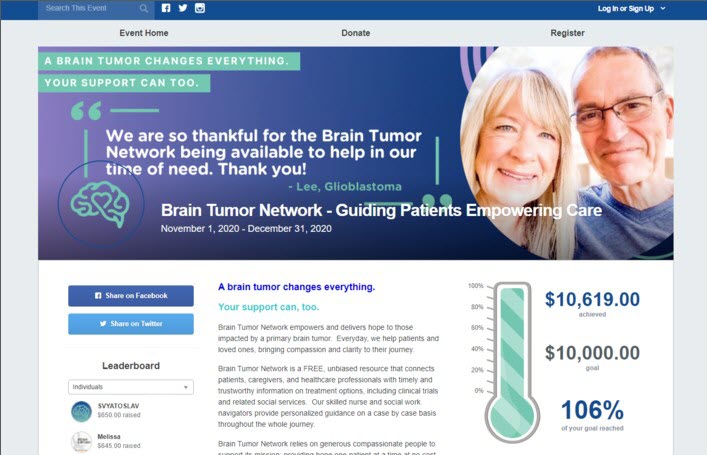
- Social media: Try encouraging your supporters to share their fundraising pages on their personal social media accounts to get more donations. (Pro tip: Qgiv’s platform integrates with Facebook fundraisers!)
- Direct mail: Who doesn’t love getting snail mail around the holidays? Try mailing your supporters a batch of holiday-themed fundraising postcards. Make sure they include a QR code and link to your donation form. Encourage your peer-to-peer supporters to send them to their family and friends chain letter-style, and watch the donations roll in!
With the right platform, you can get your supporters excited about earning support for your cause. Make sure to choose one that can help you gamify the process with virtual badges and fundraising thermometers!
10. Host a hybrid event.
Everyone enjoys attending an event for something they care about. The problem with end-of-year giving events, however, is that many of your supporters have other holiday responsibilities and just don’t have the time to attend. Some may also feel uncomfortable attending in-person events during the COVID-19 pandemic.
Instead of hosting a traditional in-person event, try a flexible hybrid event instead. Plus, you can keep the in-person portion of the event smaller to reduce the spread of COVID-19. Then, offer virtual participation methods for those who can’t or don’t feel comfortable attending in person.
Here are some hybrid events perfect for the year-end season:
- Polar Bear Plunge: Have supporters collect pledges prior to their jump into an icy river or lake. Livestream the event for participants who prefer to watch from the coziness of their couch!
- Soup Cook-Off: In-person participants register as teams and compete to make the best soup. Local livestream participants can then order a bowl of soup to be delivered to their home and participate in the judging.
- Ugly Sweater Party: Have participants bring their own sweaters and sell craft items they can use to decorate them with. Make sure to mail out at-home participants’ chosen craft items beforehand. Then vote on the ugliest sweater of the night!
- Holiday Concert: Sell tickets for a holiday-themed concert put on by a local band. Get your at-home participants engaged by collecting their song requests in advance and having the band incorporate them into their set list!
- Cross Country Ski-a-Thon: Have participants collect pledges in advance of the ski-a-thon and then ski as many miles as they can over a set amount of time. Host a meet-up on the last day to give out hot chocolate and high fives, and then get to work collecting the pledges your skiers have earned!
Want more info on how to pull off a great hybrid event? Download our hybrid event planner!
11. Create a recurring giving campaign.
A recurring giving campaign may not bring in as many donations upfront for your year-end campaign, but it will give you a steady and sustainable income you can rely on into the new year.
According to our research, monthly donors give 42% more in one year than one-time donors do. That means a monthly giving program is well worth investing in!
You can easily incorporate monthly giving into your current donation page as well. Check out how the Learning Resource Center of Polk County included an option on their donation form to multiply impact by turning a one-time donation into a recurring donation:
12. Use social media.
There are a number of ways you can incorporate social media into end-of-year giving in order to get people talking about your campaign and sharing your donation tools. Here are a few different options:
- Use Facebook fundraisers or share peer-to-peer fundraising pages.
- Go live on your Facebook or Instagram profiles to announce updates on your campaign goals.
- Use direct messaging to communicate with new supporters during your campaign so you can retain them into the new year.
- Share photos of your campaign events or volunteer opportunities to highlight the human side of your cause.
- Use social media to promote your text fundraising campaign. Pilgrim Pines did this through a video:
- Post videos explaining your cause and why the end-of-year season is important to your nonprofit.
- Tweet live updates on your fundraising goals.
- Encourage supporters to use a hashtag specific to your campaign so all related posts are grouped together when searched. Soujourner House, for example, used the hashtag “ImWithSojo for a fundraising campaign:
Whatever strategy you land on for your social media campaign, remember to consider your audience’s needs and preferences! This will strengthen your brand on social media.
See how Qgiv can help your nonprofit make the most of end-of-year giving! Request a Demo
13. Put a matching gifts drive into action.
Matching gifts drives are excellent for encouraging your donors to increase their end-of-year donations. After all, with the opportunity to double their impact, donors will be excited to make their contributions go further.
To get your matching gifts drive up and running, reach out to an individual (such as a board member) or a local business and ask them to offer gift matching. Then, simply include the opportunity for donors to increase their impact through matching on your marketing materials.
Boston Landmarks Orchestra was able to reach 135% of their 2020 year-end fundraising goal thanks to matching gifts:
14. Show the impact your donors are having.
Your supporters won’t be motivated to donate to your nonprofit just because it’s the end of the year. They want to know their donations matter and see the impact that they have on your cause.
You can show that impact by sharing a human story. Here are some storytelling tips:
- Tap into people’s love of narrative. Show a conflict and how it was/can be resolved thanks to your donors. This allows you to give your donors a story with a beginning, middle, and end!
- Be descriptive. Instead of quickly mentioning how you were able to deliver 17 truckloads of shoes to your beneficiaries, describe the delivery to your donors. What was the weather like? How did your beneficiaries react? What style and colors of shoes were packed in the trucks?
- Use visuals. Whether through photos or videos, visuals can help make your donor feel like they’re truly part of your mission. Check out Brother Wolf Animal Rescue’s video that shows their supporters the animals they were able to save thanks to their help:
Describing the impact your supporters have on your cause will not only make them feel valued by your organization, it will also help you inspire them to give in the upcoming year!
15. Plan a special email welcome series for new donors.
Creating an email series for new donors can help set you up to retain them into the new year and beyond, especially when you share their donation’s impact as we mentioned above.
New end-of-year donors are a specific segment of your audience, and you should plan your email series accordingly. Here are some great email ideas to help you kick off their involvement with your organization:
- Introduce your new donors to your mission, the programs you offer, and who you help.
- Share your organization’s history and leadership information.
- Send out a survey to get to know your donors.
- Invite your donors to follow your organization on social media.
- Provide information on gift matching and recurring giving.
- Feature recent blog posts and volunteer opportunities.
When creating your email series for new donors, make sure you work with your team to decide how many emails you’re going to send and how often you will send them. Aim to be consistent in delivering your emails, but don’t send so many that it overwhelms your new donors. Each email should be poised to encourage donors to increase their involvement with your organization!
16. Learn how to write a great end-of-year appeal.
There’s a lot riding on how you ask for donations during end-of-year giving. It’s wise to take the time to revisit how to write strong donation appeals. Let’s go over the recipe for a great appeal
1.Focus on the donor first and foremost. Donations, no matter the size, are often a sacrifice for your supporters. They’re choosing to give money to your organization that they could spend elsewhere. Remember that and put your donors first. Recognize their generosity and sacrifice.
2. Tell a story. Even a brief story about how your donors have made a difference in the lives of your beneficiaries can help your donation appeal. Try sharing the story of one person to highlight the human element of your cause.
3. Use visuals. Pictures and videos bring your cause to life. Don’t be afraid to use them on your donation page or in a social media post to encourage people to give. Visuals often spark our curiosity and get us to dive a little deeper into a webpage or social media post.
4. Craft a well-worded call to action. A call to action is simply a statement that asks a donor to complete a specific task. However, some calls to action are better worded than others. For example, “Donate now” is a weak call to action compared to, “Give today and help us wipe out cancer for good.”
5. Offer multiple ways to give or get involved. Not every supporter is in a position to give a monetary donation during end-of-year giving. Offer multiple ways to get involved with your cause, whether that’s through volunteering at your end-of-year event or forwarding campaign information to friends via email.
6. Use different channels for delivering your appeals. Pay attention to what different segments of your audience need from you. Some donors will respond better to an appeal on X, for example, while others will prefer to be solicited via direct mail. Don’t forget to adapt your donation to each channel’s unique requirements.
Once you’ve mastered the art of writing end-of-year appeals, you’ll be able to better connect with your supporters and meet your year-end goals.
17. Let your supporters do the talking.
Word-of-mouth communication is the best way to spread your nonprofit’s message, and with online tools, it’s easy to get your supporters talking for you!
Here are three ways your supporters can spread the news about your end-of-year giving campaign:
- Provide a hashtag your supporters can use for your year-end campaign. A strategically-worded hashtag allows you to group all of your social media posts about your end-of-year campaign under the same umbrella. They should be easy to remember and type out so your supporters can use them without issue. Here are some good and bad examples of end-of-year giving hashtags:
- Ask supporters to post on their personal social media. Each of your supporters has their own network of friends and family members that would likely be interested in a cause someone they know and trust is involved in. Provide your supporters with tools for great social media posts. These could include templates for social media posts on different platforms, videos they can share, and even graphics like profile picture frames they can post in support of your campaign.
- Encourage supporters to email their networks. Email is a great long-form way to get your supporters talking about your work. Make it fun by providing your supporters with email templates, and then offer incentives like free swag or a raffle ticket for every 5 emails sent out!
18. Leverage the power of video.
According to our research, 57% of people who watch a nonprofit video go on to make a donation to that organization. This means video is a great tool for your end-of-year giving campaign.
Here are the elements of a great video:
- Clear and steady camerawork
- Good lighting
- Music that fits the message
- Clear and succinct audio
Here’s an example of a volunteer appreciation video made by the Pet Alliance of Greater Orlando:
19. Don’t let confirmation emails go to waste.
Donation confirmation emails should be more than a receipt. Instead of just providing numbers, make sure you take the opportunity to thank your donor sincerely for their contribution.
You should also reiterate the impact that your gift will have on your cause and encourage future involvement. For example, your confirmation emails could promote opportunities to:
- Share their donation on social media
- Opt in to your recurring giving program
- Volunteer (Pro tip: Don’t forget to include virtual volunteering opportunities!)
Remember, your donor doesn’t want to feel like they’re an ATM! That means a donation confirmation email isn’t the time or place to ask for another donation. Edit your confirmation emails to ensure they don’t come across as too pushy. Instead, let your donor choose how to engage with your nonprofit in the future.
20. Optimize your donation form.
It’s no secret that your donation form is critical to your end-of-year giving campaign. If you don’t test it well in advance of your campaign, you could face big problems on the day of your campaign launch, costing you donations.
Here are some tips for optimizing your donation form, inspired by our article on year-end donation forms:
- Make the form mobile-friendly.
- Share a story on your donation form.
- Let your donor choose from suggested donation amounts.
- Offer an option to make a one-time gift into a recurring gift.
- Streamline the donation form to keep the process short.
- Remove distractions (like external links) from your form.
Make sure your team tests your donation form well ahead of time, especially if you make big changes to it in anticipation of end-of-year giving season.
21. Conduct post-campaign analysis.
After an exhausting end-of-year giving campaign, it can be easy to want to move on and not think about the campaign again. But we recommend you resist the temptation and conduct post-campaign analysis as soon as your campaign ends.
Here are some questions your team can ask to evaluate your campaign’s success:
- Did we meet our goal? Do we still have more to do?
- How many new donors did we gain, and how did we recruit them?
- Was our division of tasks amongst staff sustainable for future campaigns?
- What marketing channel worked best for getting the word out about this campaign?
This analysis will set you up with the information you’ll want for next year’s end-of-year giving season. You can even ask questions such as, “What will we want to know next year before beginning our year-end campaign?” or, “What do we not want to forget about this campaign that could inform future campaigns?”
Final Thoughts
End-of-year giving is important for the health of your nonprofit as you move into the new calendar year. This is why it’s so important for your organization to have a solid plan and a knowledge of end-of-year giving best practices, because you’ll want to take full advantage of this unique time of year when generosity is running high.
As you follow these best practices, remember to focus on your donors’ experience and what information and encouragement they need from you to get involved.
To continue your research about end-of-year giving, check out these articles:
- 5 Easy Fundraising Ideas for Your End-of-Year Fundraising Push. Learn how to work smarter, not harder, to pull in end-of-year support.
- 2021 Year-End Workbook. Preparing for 2022? Set yourself up for success by reviewing what worked (and what didn’t!) in 2021.
- Request a demo with Qgiv to find out how they can help you get your end-of-year giving campaign up and running!

